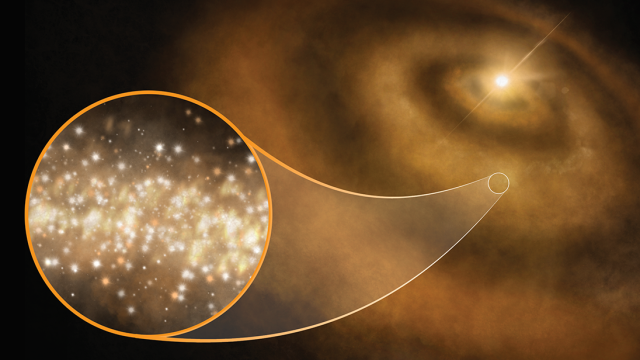For years, astronomers have struggled to understand the source of anomalous microwave emissions coming from various locations across the Milky Way galaxy. A recently concluded survey of the planet-forming disks around young stars suggests these strange transmissions are being produced by something rather extraordinary: Dense clouds of microscopic diamonds.
Artist’s impression of nanoscale diamonds surrounding a young star in the Milky Way. Illustration: S. Dagnello, NRAO/AUI/NSF
The appropriately named “anomalous microwave emissions” (AMEs) were first detected two decades ago. The faint microwave light originated from a number of regions across the Milky Way, and while scientists didn’t have an explanation for the observation, it was proposed that some type of particle was responsible.
A popular theory was that AMEs were being produced by an organic molecule known as polycyclic aromatic hydrocarbons (PAHs). These carbon-based molecules are scattered throughout space, and they feature a distinct, yet faint, infrared signature.
New research published today in Nature Astronomy suggests this interpretation was wrong, and that clouds of nanodiamonds located within embryonic star systems are the true source of AMEs.
Nanodiamonds are naturally forming bits of crystalline carbon, and with radii between 0.75 to 1.1 nanometres, they’re hundreds of thousands of times smaller than a grain of sand. These extremely tiny bits of gemstones arise within protoplanetary disks, and they’re often found inside meteorites that have fallen to Earth.
For the study, an international team of astronomers analysed the protoplanetary disk of 14 infant stars using the Green Bank Telescope (GBT) in United States and the Telescope Compact Array (ATCA) in Australia.
The AME signal was detected in three of these stars, V892 Tau, HD 97048 and MWC 297. These three star systems produced the characteristic infrared signal associated with hydrogenated nanodiamonds, that is, nanodiamonds with hydrogen-bearing molecules on the surface.
Hydrogenated nanodiamonds emerge from the superheated vapour of carbon atoms in high-energy, star-forming regions of space. Like PAHs, nanodiamonds also glow in the infrared portion of the light spectrum, but at a different wavelength.
“In a Sherlock Holmes-like method of eliminating all other causes, we can confidently say the best candidate capable of producing this microwave glow is the presence of nanodiamonds around these newly formed stars,” Jane Greaves, the lead author of the paper and an astronomer at Cardiff University in Wales, said in a statement.
Study co-author David Frayer, an astronomer at the Green Bank Observatory, said, “This is the first clear detection of anomalous microwave emission coming from protoplanetary disks.”
Upwards of one to two per cent of the total carbon located within these protoplanetary disks was involved in the formation of the nanodiamonds. Even though they’re microscopic in size, the nanodiamonds are capable of producing a signal that we can detect here on Earth. Because the nanodiamonds are so small, they’re able to spin remarkably fast – a motion that results in the release of radiation.
“This is a cool and unexpected resolution to the puzzle of anomalous microwave radiation,” said Greaves. “It’s even more interesting that it was obtained by looking at protoplanetary disks, shedding light on the chemical features of early solar systems, including our own.”
Diamonds may be rare and precious on Earth, but in the context of the cosmos, they’re remarkably abundant – and an important byproduct of planetary formation.
